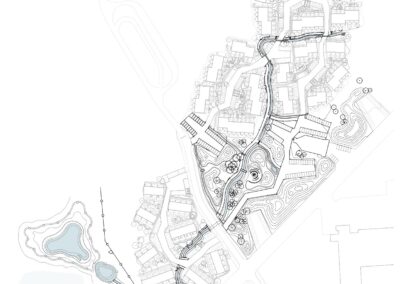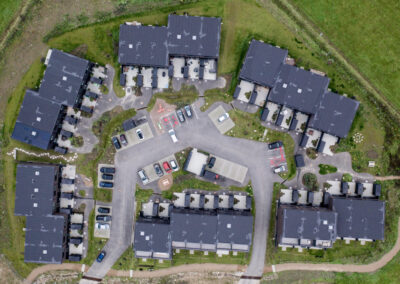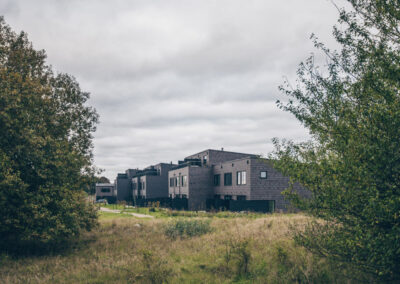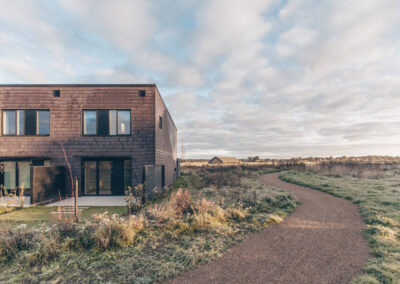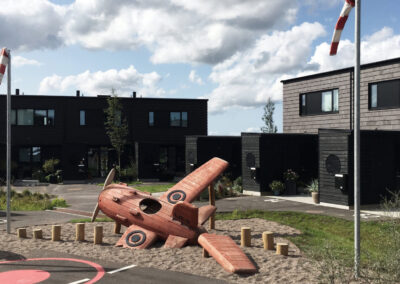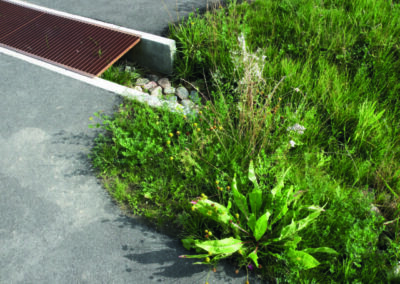
Værløse Airbase
The hybrid landscape
On the plains first shaped by the glaciers of the ice age and afterwards the use as a military airfield, Juul | Frost Architects have designed a project where the cultural-, natural- and urban landscape are merged into a hybrid landscape.
The project comprises 10 ha of landscape, including 3 open courtyards, a common area designed as a hill landscape, lakes, ditches and roads as well as 100 rowhouses. The first phase has just been realized and comprises 38 rowhouses embraced by a green and lush water sensitive landscape, and 7 ha of common area. A landscape that and accentuates the historical layers of the site, turns climate changes and challenges into potentials for recreation, leisure and learning and invites the dwellers into nature.
With its strong focus on the access to nature and neighborliness, the project underscores the office ambition to promote social, physical and mental health and shape the future’s cities of well-being.

A touch of history, a sense of belonging
The history and the spirit of the place are the pointers of the concept: the landscape takes it starting point in the military airbase history, more specifically the camouflage pattern, which is transposed into a spatial principle for planting and movement.
The camouflage layout produces different zones and spatialities between the buildings, and arranged the zones in relation to different degrees of public and private. It secures a smooth transition between the privacy of the dwelling, the semi-private patios, the semi-public space of the courtyard and the public landscape of the airfield. A graduality that promotes a feeling of security, and by extending the private space with patios, a strong sense of belonging.
The patios and edge zones generate movement and interaction along the buildings, it activates the outdoor areas, and it creates good opportunities for spontaneous meetings between the residents: The optimal condition for an informal community life to thrive.
Climate adaptions as a catalyst for change
Like in the ice ages, the waterways shape the landscape again. To evoke a reflection, to help people comprehend the climate changes and to inspire a more sustainable way of life the climate adaption is made visible and turned into new potentials.
In the courtyards the water harvesting secures a lush and green vegetation resilient towards the changing climate and cloudbursts, and an inviting common zone with views and contact to nature.
The water sensitive urban design integrates the water cycle, including storm water and groundwater management into the landscape, by drainage off all rain water from roofs, paths and surfaces through open channels. These channels lead the water to two newly designed lakes just outside the residential area, from which it re-enters the natural cycle: a new local destination to visit.
Bioidentity creates biodiversity
While the housing units are designed likewise across the three clusters, each have a distinctive identity with regards to the plant schemes. Each cluster has its own bioidentity referable to the surrounding landscape and local nature, respectively the “plain”, the “wood” and the “pasture”, that gives their unique atmospheres through the use of local species.
The local nature is drawn in between the buildings, thereby bringing the dwellers closer to nature. ‘The plain’ is characterized by grasses, trees and herbaceous perennials in reddish tones, among others purple loosestrife and rowan, while the the “wood” takes in the flora of the forest floor, and there are, among others, wild strawberry and wood anemone, European crab apple and bird cherry. The “pasture” identity is promoted by different grasses and yellowish herbaceous perennial like the tansy.
In total the residential area will become home for around 44 different species of local flora, thereby supplying the area with a rich biodiversity, and livelihood for insects and animals.
Project details
Design: Juul Frost Arkitekter
Project Location: Faldskærmsvej, Værløse, Denmark
Typology: Residential landscape
Built: 2018-2019
Design Year: 2016-2018
Client: BONAVA, Freja Ejendomme
Photo credits: © Astrid Maria Busse Rasmussen

Juul Frost Arkitekter
Juul Frost Arkitekter is an award-winning multidisciplinary design studio with a holistic approach and a human focus. The purpose of their architecture and urban development is to promote quality of life, health and well-being. Their work starts with customers’ needs and good communication. They take pride in excellent teamwork and strive to be a reliable and solution-oriented partner. Their core competencies include long-term strategic urban development and innovative housing. They are a preferred supplier due to the extensive experience in urban spaces, landscape design, campuses and residential and commercial areas.
